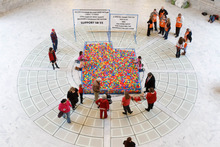This is an archived article that was published on sltrib.com in 2013, and information in the article may be outdated. It is provided only for personal research purposes and may not be reprinted.
With a huge colorful pit of 18,532 balls — each representing a Utah child with autism — set up in the Capitol rotunda on Friday, advocates hoped to drive home the impact of the complex brain disorder on the state's families.
While the pit served as a kid magnet Friday, Layton resident Mirella Petersen also plans to later give lawmakers jars stocked with gum balls: 639 for senators and 247 for House members — one for each autistic child in their districts.
The goal is to keep the dialogue going about SB 55, legislation that Sen. Brian Shiozawa, R-Cottonwood Heights is sponsoring to require insurers to cover autism treatment. The bill emerged from the Senate Business and Labor committee Thursday on a 5 to 2 vote after vigorous discussion.
SB55 covers children through age 17, with a benefit of $50,000 a year for those through age 8 and $25,000 for older children. Advocates cite a study of mandates passed in five states that showed the average premium increase was 31 cents per member per month.
But the insurance industry questions the projected costs and considers the bill premature, saying the state should await the outcome of three treatment pilot projects approved in lieu of a mandate last year.
"The insurance industry is fiercely opposed to this bill," said Petersen, who has served as president of the Utah Autism Coalition since May 2011, a few months after her then-four-year-old son was diagnosed.
"Several of their members have said to me that they are not against treatment for kids with autism. They are against being mandated to provide insurance."
Nationwide, an average of one in 88 children register somewhere along the broad spectrum for autism, and in Utah that number rises to one in 47.
twitter: @catmck —
About Utah's autism treatment pilots
Medicaid • The state is spending $4.5 million, plus $10.5 million in federal funds, to provide free treatment for up to 250 children for two years through a Medicaid pilot. Unlike the traditional Medicaid plan, the autism pilot doesn't take into account the income of the parents. Once their children are on the pilot, those children also can receive coverage for doctor visits, medications and hospitalizations unrelated to autism. A conservative estimates pegs those costs at $1.7 million for the first year, though Medicaid would be a secondary payer if the child's family has private insurance.
State insurance • The state also allocated $1.5 million to cover 50 children of state employees.
Treatment account • It will spend another $1 million to treat 15 children through a program called the Autism Treatment Account, which also received $500,000 from Intermountain Healthcare and $250,000 from Zions Bank. Those donations will treat an additional 10 children, according to the Utah Department of Health. No insurance company has donated to the fund, even though last year's bill allowed the companies to count the contributions as part of their federally required efforts to spend up to 85 percent of their collected premiums on medical benefits.













